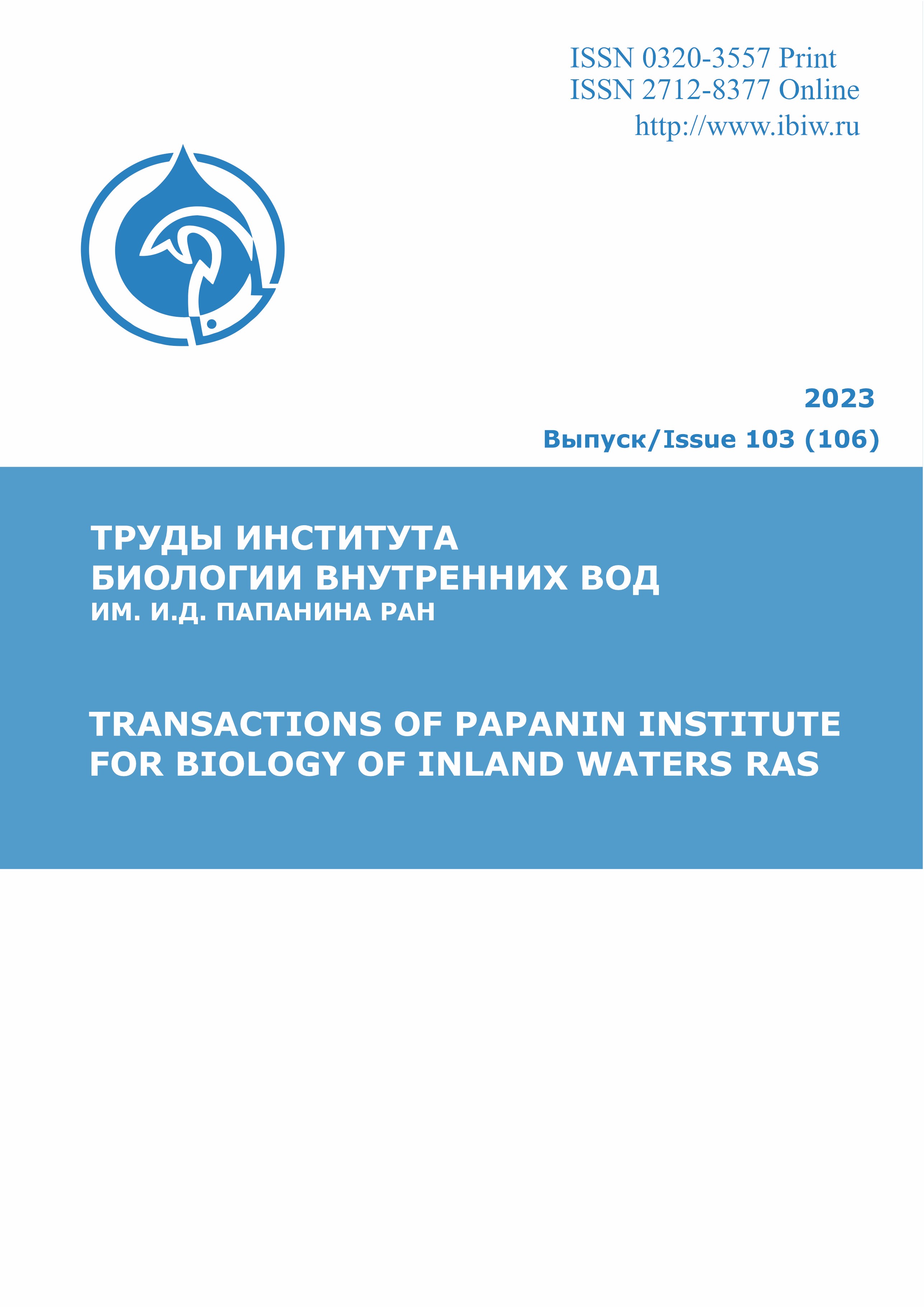Культуральным подходом и методом высокопроизводительного секвенирования определены численность колониеобразующих единиц (КОЕ), состав и таксономическая структура грибной биоты в донных грунтах Горячинского геотермального источника (Бурятия, Российская Федерация). Численность грибов в грунтах (0–3 см) в месте выхода источника и водотоке на небольшом расстоянии (3–100 м) варьировала в диапазоне от нескольких единиц до сотни КОЕ в 1 г. Посевами на питательные среды выделено 70 изолятов грибов, 34 морфотипов, из которых 15 идентифицировано до вида и 2 – до рода. Это были термофильные и термотолерантные виды Aspergillus fumigatus, A. niger, A. nishimurae, A. terreus, Melanocarpus albomyces, Mycothermus thermophilus, Naganishia brisbanensis, Penicillium sp., Pseudothielavia terricola, Rhodotorula sp., Scedosporium apiospermum, Talaromyces flavus, Thermomyces dupontii, Thermothielavioides terrestris и Vishniacozyma carnescens. Методом высокопроизводительного секвенирования ITS2 участка рДНК в грунтах источника выявлено на порядок большее разнообразие грибов (149 видов 132 родов), а всего обоими подходами обнаружено 160 видов. Число идентифицированных операционно-таксономических едициц (ОТЕ) до вида составило 64.4%. Помимо аскомицетов и базидиомицетов, которые выявляли в посевах на питательные среды, ДНК-баркодингом показано наличие в грунтах представителей отделов Mucoromycota, Mortierellomycota, Zoopagomycota, Chytridiomycota, Rozellomycota. Причем среди установленных высокопроизводительным секвенированием грибов были не только термотолеранты, но и виды с различной устойчивостью к высоким температурам и трофической ориентацией. Применение обоих подходов дало более детальную информацию о разнообразии грибных организмов в горячем источнике. Однако для выявления видов – обитателей таких экотопов, необходим тщательный анализ их физиолого-биохимических свойств (который для многих таксонов отсутствует в должном объеме) и использование иных подходов.
грибы, термальные источники, донные грунты
1. Бабьева И.П., Чернов И.Ю. Биология дрожжей. М.: Товарищество науч. изд. КМК. 2004. 221 с.
2. Бонч-Осмоловская Е.А., Мирошниченко М.Л., Слободкин А.И., Соколова Т.Г., Карпов Г.А., Кострикина Н.А., Заварзина Д.Г., Прокофьева М.И., Русанов И.И., Пименов Н.В. Биоразнообразие анаэробных литотрофных прокариот в наземных гидротермах Камчатки // Микробиология. 1999. Т. 68. № 3. С. 398-407.
3. Бонч-Осмоловская Е.А., Мирошниченко М.Л. Термофильные бактерии из горячих источников Бурятии // Экологические проблемы микробиологии и биотехнологии Байкальского региона: Тез. докл. Междунар. конф. Улан-Удэ: Изд-во БНЦ СО РАН, 1995. С. 47-49.
4. Воронин Л.В. Грибы и грибоподобные организмы в пресноводных экосистемах: учебное пособие. Ярославль: “Филигрань”, 2023. 123 с.
5. ГОСТ 11623-89. Торф и продукты его переработки для сельского хозяйства. Методы определения обменной и активной кислотности. Москва, 1990. 5 с.
6. ГОСТ 26213-2021. Почвы. Методы определения органического вещества. Москва, 2021. 7 с.
7. Грибковые инфекции: руководство для врачей. 2-е изд. М.: ООО “Издательство “БИНОМ. Лаборатория знаний”, 2008. 480 с.
8. Дашиева Ж.Д. Фитоценотическая приуроченность и определение содержания флавоноидов в смилацине трехлистной. Растительный мир Байкальской природной территории: современное состояние и перспективы исследований: материалы региональной молодежной научно-практической конференции. Улан-Удэ, 2014, С. 13-14.
9. Кочеткова Т.В., Подосокорская О.А., Ельченинов А.Г., Кубланов И.В. Разнообразие термофильных прокариот в природных горячих источниках Российской Федерации // Микробиология. 2022. Т. 91. № 1. С. 3-31. DOI:https://doi.org/10.31857/S0026365622010062.
10. Меркель А.Ю., Подосокорская О.А., Соколова Т.Г., Бонч-Осмоловская Е.А. Разнообразие метаногенных архей в наземном горячем источнике 2012 (Долина гейзеров, Камчатка) // Микробиология. 2016. Т. 85. № 3. С. 327-336. DOI:https://doi.org/10.7868/S0026365616030095.
11. Методика выполнения измерений массовой доли элементов в пробах почв, грунтов и донных отложений методами атомно-эмиссионной и атомно-абсорбционной спектрометрии. М-МВИ-80-2008. Санкт-Петербург. 2008. С. 27.
12. Намсараев З.Б., Зайцева С.В., Дмитриева О.М., Бархутова Д.Д. Структура и функциональная активность микробных матов термального источника Гарга (Баргузинская котловина) // Вестник Бурятского государственного университета. Биология, география. 2011. № 4a. С. 231-239.
13. Напрасникова Е.В., Белозерцева И.А. Почвы восточного побережья озера байкал и их эколого-микробиологическая характеристика // Вестник Камчатского государственного технического университета. 2020. №. 54. C. 108-116. DOI:https://doi.org/10.17217/2079-0333-2020-54-108-116.
14. Booth C. Fusarium. Laboratory guide to the identification of the major species. Surrey, England: C.M.I., Kew, 1977. 57 p.
15. Chen K.Y., Huang D.J., Liu C.C. The mycoflora of hot spring soil in northern Taiwan // Taiwania. 2003. Vol. 48. № 3. P. 203-211.
16. Chen M.Y., Chen Z.C., Chen K.Y., Tsay S.S. Fungal flora of hot springs of Taiwan (1): Wu-Rai // Taiwania. 2000. Vol. 45. № 2. P. 207-216.
17. Crous P.W., Braun U., Schubert K., Groenewald J.Z. The genus Cladosporium and similar dematiaceous hyphomycetes // Stud. Mycol. 2007. Vol. 58. P. 1-253.
18. De Hoog G.S., Guarro J., Gené J., Figueras M.J. Atlas of Clinical Fungi. 3rd edn. CBS-KNAW Fungal Biodiversity Centre, Utrecht, 2011. 1126 p.
19. Di Piazza S., Houbraken J., Meijer M., Cecchi G., Kraak B., Rosa E., Zotti M. Thermotolerant and thermophilic mycobiota in different steps of compost maturation // Microorganisms. 2020. Vol. 8. № 6. P. 880. DOI:https://doi.org/10.3390/microorganisms8060880.
20. Dijksterhuis J. Food Mycology. Heat-resistant ascospores. Eds.: Dijksterhuis J., Samson R.A. CRC Press, Boca Raton, 2007, pp. 101-117.
21. Domsch K.H., Gams W., Anderson T.-H. Compendium of soil fungi. IHW-Verlag, Eching, 2007. 672 p.
22. Ellis M.B. Dematiaceous Hyphomycetes. Surrey, England: C.M.I., Kew, 1971. 608 p.
23. Ghajari A., Latifi A., Lotfali E. Fungal contamination of improved hot springs in Mazandaran province, fall 2014 // Pejouhesh dar Pezeshki. 2017. Vol. 41. № 1. P. 50-55.
24. Ghajari A., Latifi A., Niyati M., Lotfali E. An Investigation of Fungal Contamination in Hot Springs of Mahallat City, Summer 2016 (Iran) // Qom University of Medical Sciences Journal. 2018. Vol. 11. № 12. P. 76-83.
25. Gleason F.H., Scholz B., Jephcott T.G., van Ogtrop F.F., Henderson L., Lilje O., Kittelmann S., Macarthur D.J. Key ecological roles for zoosporic true fungi in aquatic habitats // Microbiol. Spectrum. 2017. Мol. 5. № 2. P. 10-1128. DOI:https://doi.org/10.1128/microbiolspec.funk-0038-2016.
26. Guarro J., Kantarcioglu A.S., Horré R., Rodriguez-Tudela J.L., Cuenca Estrella M., Berenguer J., de Hoog G.S. Scedosporium apiospermum: changing clinical spectrum of a therapy-refractory opportunist // Med. Mycol. 2006. Vol. 44. № 4. P. 295-327. DOI:https://doi.org/10.1080/13693780600752507.
27. Grigoriev I.V., Cullen D., Goodwin S.B., Hibbett D., Jeffries T.W., Kubicek C.P., Kuske C., Magnuson J.K., Martin F., Spatafora J.W., Tsang A., Baker S.E. Fueling the future with fungal genomics // Mycology. 2011. Vol. 2, № 3. P. 192-209. DOI:https://doi.org/10.1080/21501203.2011.584577.
28. Kambura A.K., Mwirichia R.K., Kasili R.W., Karanja E.N., Makonde H.M., Boga H.I. Diversity of fungi in sediments and water sampled from the hot springs of Lake Magadi and Little Magadi in Kenya // Afr. J. Microbiol. Res. 2016. Vol. 10, № 10. P. 330-338.
29. Kirk P.M., Cannon P.F., Minter D.W., Stalpers J.A. Dictionary of the Fungi (10th edition). CABI, Wallingford, UK, 2008. 2600 p.
30. Klich M.A. Identification of Common Aspergillus Species. CBS, Utrecht, 2002. 528 p.
31. Lee H., Tang H. Evolutionary Genomics: Statistical and Computational Methods, Volume 1. Next-generation sequencing technologies and fragment assembly algorithms. Totowa, NJ: Humana Press, 2012. P. 155-174.
32. Lepere C., Domaizon I., Humbert J-F., Jardillier L., Hugoni M., Debroas D. Diversity, spatial distribution and activity of fungi in freshwater ecosystems // Peer J. 2019. Vol. 7. P. e6247. DOI:https://doi.org/10.7717/peerj.6247.
33. Maheshwari R., Bharadwaj G., Bhat M.K. Thermophilic fungi: their physiology and enzymes // Microbiol. Mol. Biol. Rev. 2000. Vol. 64. № 3. P. 461-488. DOI:https://doi.org/10.1128/mmbr.64.3.461-488.2000.
34. Nguyen N. H., Song Z., Bates S. T., Branco S., Tedersoo L., Menke J., Schilling J.S., Kennedy P. G. FUNGuild: an open annotation tool for parsing fungal community datasets by ecological guild // Fungal Ecol. 2016. Vol. 20. P. 241-248. DOI:https://doi.org/10.1016/j.funeco.2015.06.006.
35. Özdemir S.Ç., Uzel A. Bioprospecting of some hot springs and compost in West Anatolia regarding phytase producing thermophilic fungi // Sydowia. 2020. Vol. 72. P. 1-11. DOI:https://doi.org/10.12905/0380.sydowia72-2020-0001.
36. Raper K. B., Thom C. A manual of the Penicillia. Baltimore: The Williams and Wilkins Company, 1949. 878 p.
37. Raper K.B., Fennell D.I. The Genus Aspergillus. Baltimore: The Williams and Wilkins Company, 1965. 686 p.
38. Raper K.B., Thom C., Fennell D.I. A Manual of the Penicillia. New York and London: Hafner Publishing Company, 1968. 875 p.
39. Ramírez C. Manual and Atlas of the Penicillia. Amsterdam: Elsevier Biomedical Press, 1982. 874 p.
40. Redman R.S., Litvintseva A., Sheehan K.B., Henson J.M., Rodriguez R.J. Fungi from geothermal soils in Yellowstone National Park // Appl. Environ. Microbiol. 1999. Vol. 65, № 12. P. 5193-5197. DOI:https://doi.org/10.1128/AEM.65.12.5193-5197.1999.
41. Rifai M.A. A revision on the genus Trichoderma // Mycological Prpers. 1969. Vol. 116. P. 1-56.
42. Salano O.A., Makonde H.M., Kasili R.W., Wangai L.N., Nawiri M.P., Boga H.I. Diversity and distribution of fungal communities within the hot springs of soda lakes in the Kenyan rift valley // Afr. J. Microbiol. Res. 2017. Vol. 11, № 19. P. 764-775.
43. Samson R.A, Houbraken J. Phylogenetic and taxonomic studies on the genera Penicillium and Talaromyces // Stud. Mycol. 2011. Vol. 70. P. 1-183.
44. Schipper M.A. On certain species of Mucor with a key to all accepted species; On the genera Rhi-zomucor and Parasitella // Stud. Mycol. 1978. Vol. 17. P. 1-71.
45. Seifert K., Morgan-Jones G., Gams W., Kendrick B. The Genera of Hyphomycetes. CBS-KNAW Fungal Biodiversity Centre, Utrecht, 2011. 997 p.
46. Sharma N., Vyas G., Pathania S. Culturable diversity of thermophilic microorganisms found in hot springs of northern Himalayas and to explore their potential for production of industrially important enzymes // Scholars Acad. J. Biosci. 2013. Vol. 1, № 5. P. 165-178.
47. Singh P., Raghukumar C., Verma P., Shouche Y., Fungal community analysis in the deep-sea sediments of the Central Indian Basin by culture-independent approach // Microb. Ecol. 2011. Vol. 61. P. 507-517. DOI:https://doi.org/10.1007/s00248-010-9765-8.
48. Tanunchai B., Ji L., Schroeter S.A., Wahdan S.F.M., Hossen S., Delelegn Y., Buscot F., Lehnert A-S., Alves E.G., Hilke I., Gleixner G., Schulze E-D., Noll M., Purahong W. FungalTraits vs. FUNGuild: comparison of ecological functional assignments of leaf-and needle-associated fungi across 12 temperate tree species // Microb. Ecol. 2023. Vol. 85, № 2. P. 411-428. DOI:https://doi.org/10.1007/s00248-022-01973-2.
49. Velez P., Salcedo D.L., Espinosa-Asuar L., Gasca-Pineda J., Hernandez-Monroy A., Soto L. A. Fungal Diversity in Sediments From Deep-Sea Extreme Ecosystems: Insights Into Low- and High-Temperature Hydrothermal Vents, and an Oxygen Minimum Zone in the Southern Gulf of California, Mexico // Front. Mar. Sci. 2022. Vol. 9. P. 802634. DOI:https://doi.org/10.3389/fmars.2022.802634.
50. Von Arx J.A. The Genera of fungi sporulating in pure culture. 3rd edn. Vaduz: J. Cramer, 1981. 424 p.
51. Xu W., Gong L. F., Pang K. L., Luo Z. H. Fungal diversity in deep-sea sediments of a hydrothermal vent system in the Southwest Indian Ridge // Deep Sea Res., 2018. Vol. 131. Part I. P. 16-26. DOI:https://doi.org/10.1016/j.dsr.2017.11.001.








